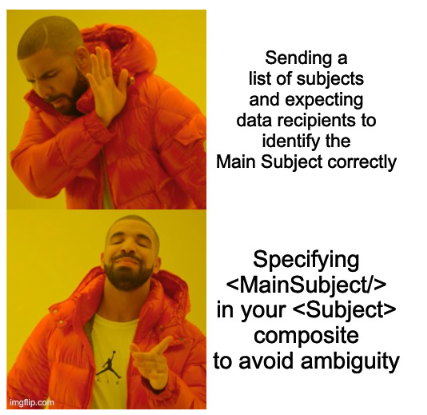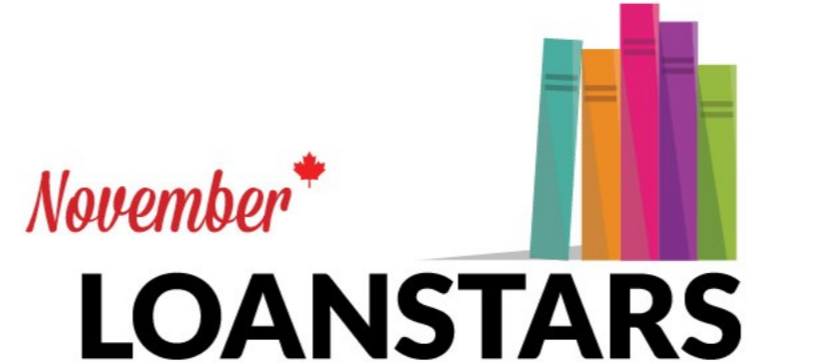At BookNet, metadata is at the core of what we do. With so much of it flowing in and out of our products and services, we’ve seen it all. In this blog series, we will share each of the common issues addressed in the Improving your metadata: Common issues and how to fix them Tech Forum presentation where eight BookNetters walk you through some of the most common issues we see in publishers’ metadata, highlighting what metadata standards are recommended for each case and showing you how to fix these common problems.
Why is this important? Accurate, high-quality metadata ensures your books are seen and that they succeed in today’s competitive marketplace. Join us as we help you optimize your metadata and unlock its full potential!
Image source: Drake Hotline Bling Meme Generator - Imgflip
The issue: Failing to supply a Main Subject
When it comes to a book’s metadata, <MainSubject> is an essential component that provides clarity. Adding it to your ONIX means that not only will you be meeting Best Practices for the North American market and beyond, but you'll also remove opportunities for ambiguity by telling data recipients exactly which subject is the most important one to consider when classifying a book.
Why is this an issue?
When a publisher creates bibliographic data to send to downstream data recipients, the publisher is distilling down all of their collected wisdom about that book across many different departments and job functions. Data recipients rely on that collected wisdom to make decisions about the book to support its sale.
When publishers don't specify a main subject, the publisher hands over control of a powerful piece of bibliographic data, which may result in:
Different retailers displaying different primary subjects
Books being placed in inappropriate sections
Search and discovery suffering when systems don't know which subject to prioritize
Other implications of not specifying <MainSubject> mean that data recipients must build logic on how to handle books that do not include a <MainSubject>. This decision-making is often opaque to data senders and data senders lose control of this key sales and marketing piece. Another consideration is the fact that data recipients must build policies on how to handle subject code updates/changes. This is easy online but becomes tricky post-pub date for inventory in brick-and-mortar stores not to mention that library cataloguing is often resistant to bibliographic data changes post-pub date.
In one example from our presentation, a parenting book had 24 subjects across four classification schemes … with no main subject indicated. This resulted in wildly inconsistent categorization across retailers.
What BookNet recommends
1. Follow the standards
The BISAC standard states that data senders should provide no more than three codes, ordered by content focus, and choosing fewer than three is also a best practice when the codes chosen fully describe the book. Thema tops out at four plus qualifiers.
The ONIX best practices, as published by EDItEUR, agree that if classification within a particular scheme makes use of multiple categories or category codes and, therefore, more than one
subject composite, one should be flagged as being the primary category for that scheme with the main subject empty element.
Whether you’re using BISAC, Thema, or both, familiarizing yourself with these subject classification schemes' best practices is highly encouraged to not only provide trading partners and readers with the information they need but to leverage the powerful opportunities they provide.
2. Keep it specific
Don't supply multiple, barely relevant classifications in an attempt to get the product listed under as many headings as possible at a retailer or to place better on a bestseller list. For both BISAC and Thema, don't provide broad classification where you also provide a more specific code. Always use the most specific classification that is appropriate.
ONIX best practices note that there is diminishing value in providing more and more codes. Two or three thoughtfully chosen, detailed, and relevant subject categories are more useful to a retailer and to a potential purchaser than 12 or 13 that are less relevant or overly broad.
3. Don’t forget about your backlist
Analyze your active ISBNs to ensure that all titles, frontlist and backlist, include a main subject. Don't handle this on a one-off basis.
4. Connect with your trading partners
Talk to your trading partners, find out how they expect to receive information on subjects and do your best to follow both the standards and their guidelines.
5. Be the change
Evangelize for change within your organization. If you work for a firm that routinely fails to provide main subjects, BookNet is enlisting you to advocate internally for proper metadata practices!
Need help? Don't hesitate to reach out to the BookNet team with specific questions.
The complete slide deck and transcript from this session are available here.
To stay up to date, subscribe to our weekly newsletter, eNews, where we share news about upcoming events and webinars, infographics and new research, updates on industry standards, links round-ups, and more.















Happy holidays!